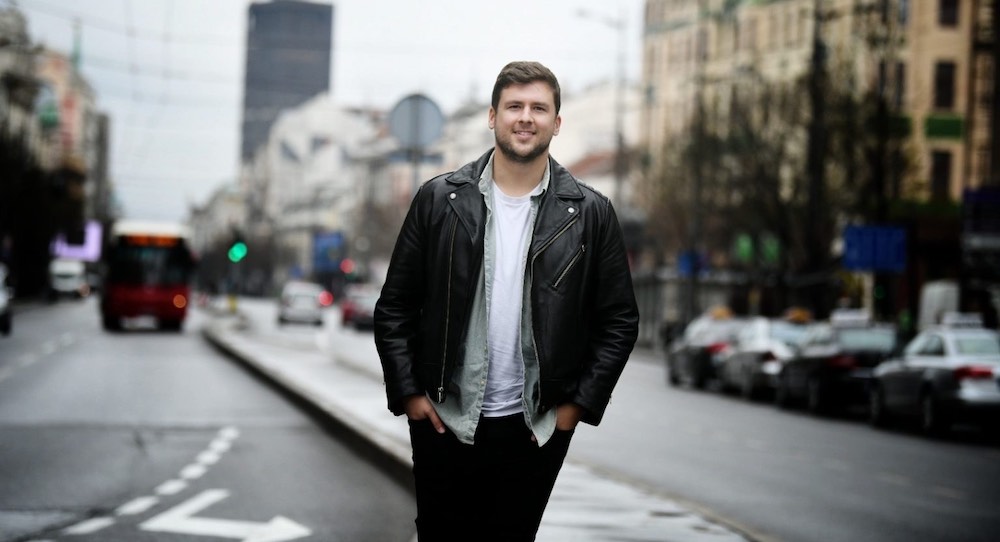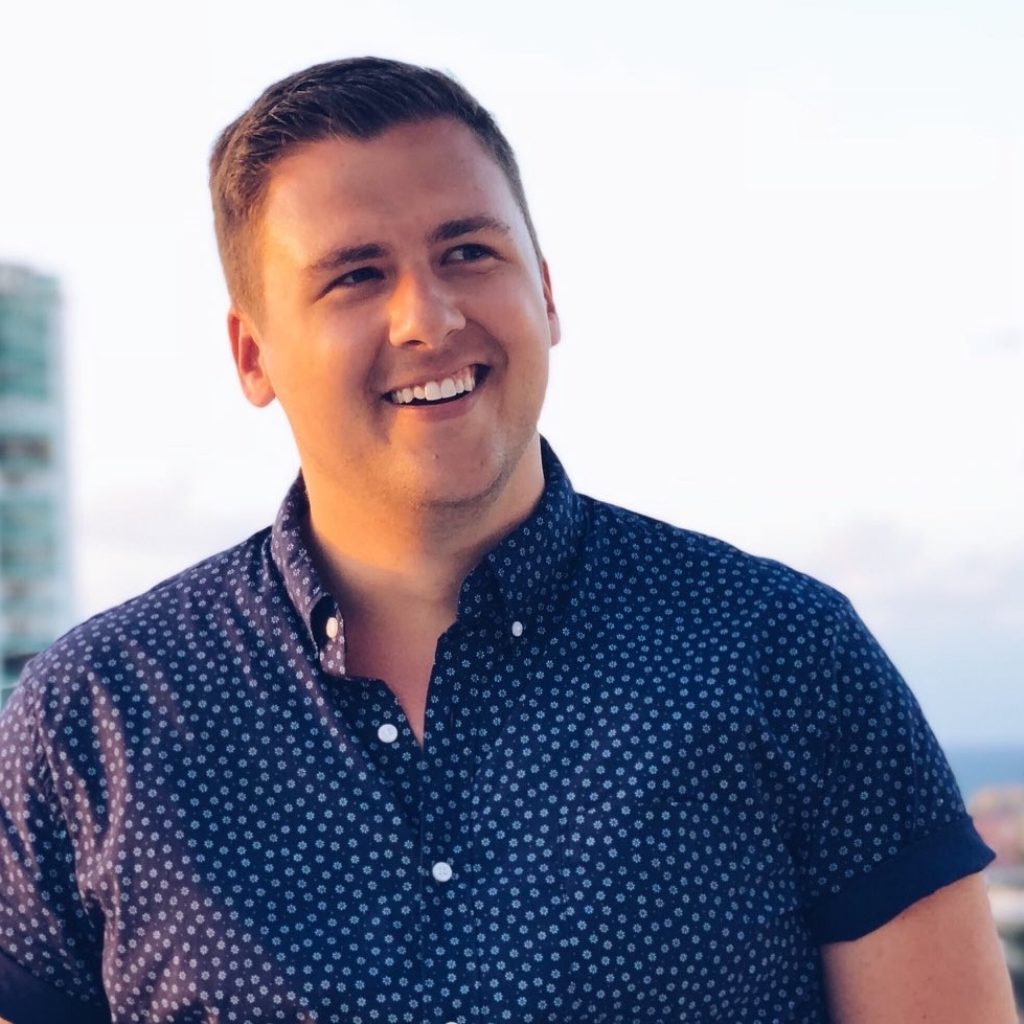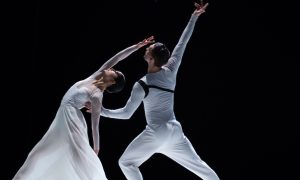Dance Informa had the opportunity to speak with Joyce Theater Productions (JTP) Producer Ross LeClair. Read on to learn about the many roles a producer of contemporary dance must fulfill, and the joy of dance that makes all the effort worthwhile.
What is your background in dance and what were the major steps that got you to where you are today?
“Following in my older sister’s footsteps, I started dancing recreationally at seven years old. Each year, I’d added on an additional class, and eventually, I moved to The Gold School. By my junior year of high school, I was dancing almost every day and decided I wanted to pursue a BFA. I attended NYU because I wanted to be able to double major in something other than dance ‘just in case.’ I double majored in dance and journalism and loved both programs as well as being in NYC. As I approached graduation, I saw two, seemingly very separate worlds before me. After completing internships at NBC News, I got a job offer from CNBC as a news associate. I wasn’t sure I was cut out to be a freelance dancer in New York, and I saw this other path offering me a career and benefits that so many dancers don’t get. I decided to leave dance altogether.
I dove into journalism as a field producer for CNBC from 2013-2016, where I learned a lot about producing, budgeting and event management. But I was missing dance. I wanted to find a way to bring my passion for dance and my administrative skills together. When I saw that the Joyce was hiring and read the job description, I got chills from head to toe. The producer position would enable me to put all the skills I’d been developing in television/broadcast journalism toward making dance. Most of the other applicants were coming from dance more directly, but my experience with project management and dealing with ‘talent’ helped me in the interview process. I’m so grateful that the opportunity to reenter the field of dance opened up for me.”
What is Joyce Theater Productions (JTP), and what’s your role within it? What does it really mean to be a producer?
“A lot of people don’t know it exists because for a long time it didn’t exist. When the Joyce first opened in the 1980s, it was primarily rented out by artists. The theater later started presenting companies, and only relatively recently did JTP get up and running. I’m actually the company’s first dedicated producer. JTP is a production company within the Joyce tasked with developing original work for the Joyce stage and for touring. The idea arose organically from projects brought to the Joyce by artists who didn’t have a company or infrastructure to support them. (Daniil Simkin’s INTENSIO is an early example.) The Joyce realized that its marketing, financial and development resources could be funneled not only into presenting but producing work. Making it from the ground up. Sometimes JTP co-produces. Sometimes a show has made it to a certain point and then we come in and help produce. The department is just me and a part-time associate producer, but I have access to all the Joyce departments.
A typical production experience starts with me approaching an artist or an artist approaching me, which often simply looks like us in a conference room together dreaming about what a project might be. We develop a budget and timeline first, and then go through the various steps of creating a work, which usually culminates in a premiere at the Joyce. We also book the touring process, and it’s a long journey from the start to the finish of a show. Some of the work starts before we even agree to produce a show, and a lot of the process is about relationship building. Sometimes there’s an artist I want to work with, but the idea or timing isn’t quite right yet, so there’s pre-producing where we figure out what to do.
From tasks that depend on human interactions like developing relationships with artists to administrative tasks like budgeting and contracting, a producer is responsible for a wide range of things. In short, while a show is being made, anytime something goes wrong (or right), the person who gets the phone call is the producer. The producer has to either have the answer or know who to call to get the answer, and is the direct line to the creative team. My role is to enable artists to get into a creative space and not worry about anything else (per diem, timing, residency dates, etc.) but making their work.”
What’s the ‘why’ behind JTP?
“First of all, the Joyce feels like it has resources to offer to artists. Second, if there’s a show or type of dance we want our audiences to experience that doesn’t exist, we can make it, which gives us more control over the things we want to see and the artists we want to support. This season, we are presenting four weeks of Joyce Theater Productions, and our season generally features from three to six weeks of work we’ve produced. Burn by Alan Cumming and Steven Hoggett opened our 2022-2023 season, and Malpaso Dance Company is also always a Joyce Theater Production.”
Are there specific companies you have an ongoing relationship with?
“Malpaso is the only company with an ongoing relationship right now, and we refer to them as an associate company of Joyce Theater Productions. The Joyce has known Malpaso’s executive director since the company’s formation 10 years ago. We’re open to taking on additional associate companies but just haven’t found the right fit yet. Part of the idea is to provide infrastructure to those who don’t have it, and in Cuba, there’s a huge lack of support for dance.”
What are the biggest challenges that come with producing contemporary dance?
“Anytime a visa process is involved, there’s a complex system to navigate that you have to know how to plan for. Working with Malpaso is particularly complicated, and has become even more so since the U.S. Embassy in Havana effectively closed in the fall of 2017. In order to enable them to travel to the U.S., we have to send them to a country like Mexico or Canada first to interview for a U.S. visa. Additionally, because the vaccines Cubans got at home are not authorized by the World Health Organization, we had to find a way to get the company vaccinated. Because Serbia was being generous with vaccines and Cubans could travel there without a visa, we got Malpaso a residency in Serbia for a month so they could work while receiving two shots of Pfizer.
The main challenge outside special cases like this one is just being adaptable and ready to make changes. I’m thinking specifically about our State of Darkness Revival by Molissa Fenley. The solo was first performed at the Joyce in 1990, and we decided to revive it by having Molissa teach the piece to seven dancers in New York. This was all happening in the late summer of 2020, and at one point we thought we’d be able to premiere it with a live audience, but the timeline kept shifting. The rehearsal process was mostly on Zoom, and there were many days I was on stage with the choreographer, a big TV and a webcam. I’d literally follow Molissa around the stage with the webcam while dancers at home learned very complicated choreography to Rite of Spring. Then we were allowed one dancer in the space. Then two. Restrictions around us kept changing, and we kept adapting with them. I certainly never thought I’d be on the Joyce stage watching Sara Mearns learn choreography from her tiny second bedroom studio. A big part of producing is dealing with the problem in front of you.”
Can you tell us about some of the productions you’re most proud of?
“The State of Darkness Revival definitely stands out. The cast was just incredible. From a young Juilliard graduate to members of renowned companies like Graham and ABT, seeing such a variety of dancers performing the same solo in their own voices was thrilling, and we all became super close. I’m actually getting dinner Tuesday at Molissa’s with the rest of the cast. With that show, due to COVID, we initially live-streamed each solo. Then we brought it back for a live audience the following year, and it was cool to see it in so many different forms. Being listed in Best Dance of 2020 by The New York Times and winning a Bessie for Outstanding Revival were welcome recognition of all that work.
Sw!ng Out by Caleb Teicher is also a highlight. It’s a fun, improvisation-based hour-long show featuring a 10-piece big band and 12 incredible Lindy Hoppers that takes you through a grand journey of what Lindy Hop can look like. There are exciting parts with aerials and big lifts as well as beautiful quiet moments. After the intermission, the band comes back and plays another 30-minute set during which the audience is invited on stage for a social dance. The Lindy Hop originated in social spaces –– not the proscenium –– and we wanted to celebrate the form in a show without pulling it completely out of context. Caleb insisted that the piece include a social dance; Sw!ng Out needed to be interactive as well as presentational. After the first few nights, people started lining up during intermission for the chance to get on stage. Some were great Lindy Hoppers and others just loved the music. As much as I love sitting in a theater, it was a blast to get up on stage. The celebratory energy in the theater was undeniable.”
How did your job change as a result of the pandemic, and is it completely ‘back to normal,’ or have there been permanent changes?
“Like most, I pivoted to virtual presentations and productions during the pandemic, including both pre-recorded and live-streamed works. It was like, ‘What are we still allowed to do, and what can we make under those parameters?’ It was exhausting at times, but we all found a way to keep going. While we now have audiences back in the theater, one thing the pandemic revealed that can’t easily be covered up is just how at risk many freelance artists are. They don’t have a safety net. I felt this even as a salaried full-time employee of an institution that was still forging ahead. COVID forced us to re-address and clarify our cancellation and refund policies, and was a huge wake-up call to how fragile the system is, and how we take care of each other. Going forward, we are being more careful and caring about the risky positions that the many freelance workers around a show often find themselves in.”
What are your favorite things about working for the Joyce?
“I feel so lucky to be working with artists I’ve admired for a long time. Others I met for the first time through this role, and I’ve fallen in love with their work very quickly. If I’m starting the process of a new show with a choreographer, sometimes it’s two to three years before it makes it to a stage. It’s a winding complicated road full of stress, questions, things falling apart and coming back together. But getting into the house and having the audience experience something great on stage –– it’s an incomparable feeling. I just love dance. I’m really happy to be a small part of the big process of helping people make work. Not only dancers but stage managers, lighting designers and the whole ecosystem around live performance. And I get to see a lot of shows!”
What are your goals as a producer going forward?
“It’s hard to see way down the road, but there are so many artists I love, and different dance styles I’ve watched and admired that I’ve not come close to working with yet. I want to keep exploring because I know there’s still a lot to uncover. I’m also interested in going both directions in terms of scale. I love going to the ballet and seeing a new Justin Peck piece with 100 dancers in gorgeous costumes in a big space, but I also enjoy smaller, more intimate works presented in even smaller spaces in the Joyce. The goal is just more. I love dance to my core, and I want to keep seeing it happen and playing whatever part I can in that.”
By Charly Santagado of Dance Informa.














